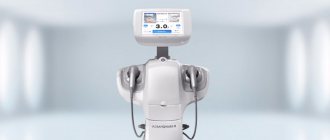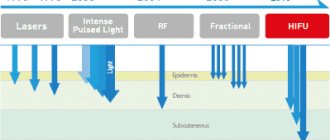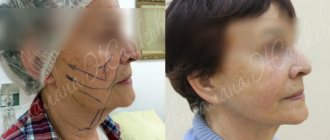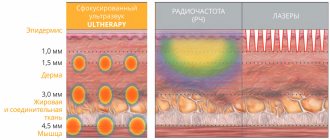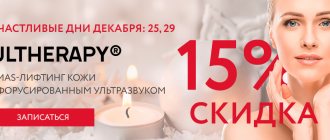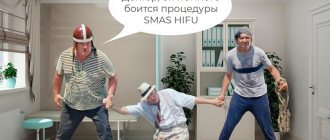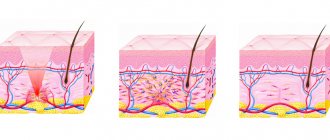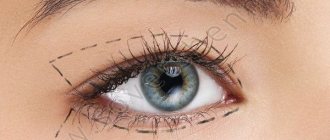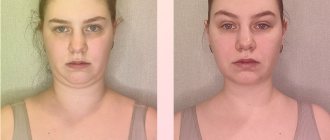- Prima-lifting – deep SMAS facial lifting with the shortest incision. Intended for young and middle-aged patients who do not have significant excess fatty tissue and skin in the neck area. More details
Doctor Bely's blog in Yandex Zen
All the latest news about plastic surgery
If you are planning a SMAS lift and want to perform this operation with a minimal incision, leave a request on our website or sign up for a consultation by phone number 5.
About Doctor Bely
I.A. Bely – professor, doctor of medical sciences. An international class expert in the field of short-suture facial plastic surgery, organ-preserving blepharoplasty, neck plastic surgery...
SMAS lifting in Moscow: who is it suitable for?
The SMAS facelift is intended for women and men who would like to look like they did 10–15 years ago. If you have tried to achieve this with the help of cosmetology, but the procedures have ceased to bring the desired result, perhaps it is time to seek help from a plastic surgeon.
SMAS lifting in Moscow is offered by many surgeons. When choosing a specialist, you need to take into account his experience and qualifications, the level of the clinic, and reviews of patients who have had surgery with this surgeon. SMAS-lift has different costs for different surgeons in Moscow, depending primarily on the qualifications of the surgeon and the technical equipment of the clinic. But if you need a significant rejuvenation effect without traces of the surgeon’s work, Dr. Bely is the only right choice. Why? Yes, simply because he is a specialist who can perform a SMAS lift through the shortest incision in the world!
HIFU devices in aesthetics
In 2004, preclinical testing of a prototype device for tissue tightening using high-intensity focused ultrasound began. And already in 2007, White et al reported the first successful use of a HIFU device in dermatology.2
In their study, the scientists assessed the effect of high-intensity focused ultrasound on a human cadaver specimen. They first imaged the facial musculoaponeurotic system (SMAS) using classical ultrasound and then targeted it with HIFU.
High-intensity focused ultrasound was found to create zones of thermal damage in the SMAS of reproducible localization, area and volume. This became the impetus for a closer study of the anti-aging properties of HIFU, which could be used in cosmetology.
In 2009, the American regulator FDA approved an ultrasound HIFU therapy device for eyebrow lifting. A few years later, HIFU was approved for face lifting, neck lifting and other aesthetic indications.
Why is SMAS lifting, whose price is higher than average, more profitable than a regular lift?
- An operation performed by an experienced surgeon gives a more natural and beautiful result. You don't have to spend money on additional correction!
- SMAS lifting is always a longer-term effect. You won't need to seek another lift in 3-5 years!
Rehabilitation is easy and painless. Unlike a traditional circular lift, SMAS lifting does not tighten the skin, does not distort the outline of the mouth, the shape of the eyes and facial expressions.
See more before and after face lift images in the Photo Gallery
How safe is hardware facial lifting?
The capabilities of the Doublo System device allow you to adjust the depth and intensity of penetration of ultrasound radiation. Therefore, the impulses affect only superficial tissues, but not deep-lying muscles. If the patient complains of discomfort, the doctor will be able to immediately reduce the radiation power. This eliminates the risk of burns.
With ultrasonic SMAS lifting, the skin remains unharmed, which guarantees the absence of infection. There is no rehabilitation period required after the procedure. Unpleasant consequences boil down to slight swelling, which goes away in three to four days, and mild pain in the facial muscles, which can be compared to the sensations after physical exercise. There are few contraindications to the procedure:
- acute purulent processes and open wounds on the skin;
- mental illness;
- skin oncology;
- blood diseases;
- thrombophlebitis;
- the presence of implants under the skin;
- wearing a pacemaker.
How does a SMAS lift work?
The purpose of the operation is to return all soft tissues of the face without exception to a higher position - the one they occupied in youth, reliable fixation of these tissues and tightening of the skin with excision of its excess. The SMAS lift is always performed under general anesthesia. The duration of the operation is from 2 to 4 hours.
The peculiarity of the SMAS operation with Dr. Bely is that all these actions are performed through a very short incision (2-3 times shorter than with any other surgeon). The choice of a suitable technique is determined by plastic surgeon I. A. Bely individually: depending on the indications, wishes and characteristics of the patient’s anatomy.
Operating principle
A typical HIFU lifting machine consists of a power supply, a computer station, a monitor and a handle with replaceable dual-use sensors. Each such sensor can not only have a HIFU effect on tissues, but also visualize their structure using an ultrasonic wave. On the monitor in real time, the doctor sees the anatomy of the patient’s face, the condition of his epidermis, dermis, subcutaneous fatty tissue and, of course, the muscular aponeurotic system - SMAS. This allows you to control the depth of the impact and adjust the procedure parameters directly during the session, which contributes to more effective and safe work.
Ultrasound imaging of the HIFU lifting device allows you to examine tissue to a depth of up to 8 mm, demonstrating on the screen the condition of the muscles and underlying bone structures of the face. Naturally, to correctly interpret what you see, you need certain knowledge and proper experience. It is worth noting that not all HIFU devices have the possibility of ultrasound visualization.
During the tissue lifting procedure, the transducer of the ultrasonic HIFU therapy device transmits a directed ultrasound wave to the focal point. Absorption of ultrasonic energy causes intermolecular vibration and the release of heat (from 60 °C or more), sufficient for partial denaturation of collagen. At the same time, wedge-shaped zones of thermal damage (Thermal Injury Zones, TIZ) with a volume of 1.0-1.5 mm3 are created in SMAS. In turn, the acoustic energy surrounding the TIZ is dissipated into the tissues without significantly affecting them.4
Rice. 1. Geometry of thermal damage zones (TIZ) of pig muscles depending on power
Regarding safety, studies have shown that even when 8 J of energy is delivered to tissue, the epidermis does not suffer thermal damage.5 For example, a typical HIFU machine transducer delivers only 1.2 J of energy to a depth of 4.5 mm, making injury to the epidermis extremely unlikely.
Rehabilitation
A SMAS lift requires the patient to stay in the hospital for at least 24 hours. After SMAS lifting, the face does not hurt (the vast majority of facial surgeries are completely painless in the postoperative period).
Patients are provided with maximum comfort, attentive service and close supervision by qualified medical staff. For 3–5 days you need to wear a special fixing bandage that prevents swelling. Sutures are removed 5–7 days after surgery.
The effect of the operation will be noticeable immediately, and after 4-6 weeks it will be possible to demonstrate it to friends and colleagues. Specific rehabilitation periods may vary depending on the type of SMAS operation, individual characteristics and, of course, the patient’s compliance with the regimen.
During the rehabilitation period the following are contraindicated:
- physical and emotional overload;
- prolonged exposure to the sun;
- smoking and alcohol abuse.
Indications
The ideal patient for HIFU is relatively young, has mild to moderate skin laxity and/or mild fat ptosis. Younger patients usually have good skin elasticity and better wound healing, which is important for SMAS lifting.
Ultrasound HIFU therapy device can be recommended for:
- Smoothing the skin.
- Reducing the severity of wrinkles.
- Non-surgical face and neck lift.
- Lifting of eyebrows and lower eyelids.
- Contouring the lower jaw line.
- Improvements in the condition of the décolleté area.
It is worth noting that smoking and intense photoaging worsen the quality of the skin - this leads to a less pronounced effect. Significant tissue ptosis, pronounced displacement of facial fat packets and extremely poor skin condition can also negatively affect the result of the SMAS lifting procedure.
Author's methods of Professor I. A. Bely
Professor I. A. Bely has developed his own unique methods of carrying out SMAS lifting: 3S-LIFTING and PRIMA-LIFTING. Both methods contribute to radical facial rejuvenation; they are suitable for people with different age and anatomical characteristics. These types of lifting can be performed without deep surgical intervention, which allows Professor Bely to carry out SMAS lifting in Moscow at a fairly low price. In addition, the minimally invasive nature of these procedures reduces their pain and the duration of the rehabilitation period.
Facial aging mechanism
The SMAS consists of two layers—the superficial fascia and the facial muscles. Time has a negative impact on each of them. In the superficial fascia, the production of collagen and elastin decreases, their existing fibers stretch and lose their elasticity. The muscles, in turn, weaken and can no longer keep the underlying tissues from falling or sagging. This is how deep folds form and the contours of the face lose clarity.
Reviews about the procedure
Write a review All reviews
Sent by Tamara Ulanova
For some time, I began to notice on my face that the corners of my lips began to droop even more, and the nasolabial folds were very noticeable. I asked my daughter to look for something to correct these flaws. Thus, I reached Lantan. Without thinking for a long time, I went for a consultation. I really liked the reception at the clinic: very friendly medical staff, friendly doctors. The doctor suggested that I undergo ulthera therapy. Now my face is 10 years younger without surgery. Thank you very much to the doctors!
Sent by Vera Last summer, I found the Lantan clinic in Moscow and went for a consultation with such a problem - drooping of the edges of the lips. I'm still relatively young (43 years old) and this ruins everything. At an appointment with doctor Natalya Imaeva, we chose an alter. Of course, the procedure is not cheap and I started saving up. I made it during the New Year holidays. I liked that it’s a one-time visit, you don’t have to go several times. I took photos for myself once a week, the effect of ultrasound exposure was increasing. Thanks to the doctors!
Brief summary of types of lifting
| surgery | threads | devices | |
| efficiency | +++ | ++ | + |
| safety | + | +++ | +++ |
| rehabilitation | + | ++ | +++ |
| tissue preservation | ++ | +++ | + |
Everything described is about real lifts, when there is enough excess skin. But often the small sagging facial tissues that people come to us with do not require such serious interventions. They can be eliminated much easier and cheaper. You can read about it here>>
Liftera systems - innovative non-surgical lifting
Liftera systems is a non-surgical restoration of the oval of the face and neck area using high-frequency ultrasonic waves. The technique was developed in the USA and is used to tighten facial skin at the SMAS level, where collagen and elastin fibers are located. Unlike other methods of exposure, primarily surgical ones, the LIFTERA System is attractive due to its low trauma and safety, as well as its high efficiency - the result lasts up to three years!
What is ultrasonic lifting Liftera System
Ultrasonic lifting is performed on an outpatient basis and takes from 30 minutes to an hour and a half. The System Lifter device heats the skin at a depth of 1.5, 3 and 4.5 mm, affecting the deep and superficial layers of the dermis. The surface of the skin is not injured. As a result, collagen, together with the connective tissue of the fat layers, is shortened and thickened - a lifting effect occurs.
One procedure is enough to tighten the oval of the face and improve the skin
Benefits of lifting with the System Lifter
- High efficiency - visible changes and signs of rejuvenation are visible to the naked eye.
- The procedure is minimally invasive – no incisions or scars, scars, bruises, or smudges.
- There is no need for special training - just consult a cosmetologist.
- Easy recovery – within 7-10 days after the procedure, discomfort completely disappears.
- The versatility of the technique - patients have access to ultrasound facelift, chin and neck areas, as well as lifting of the hips, buttocks, knees, and arms.
Indications for Ultrasonic SMAS lifting
- Age-related skin changes, sagging, wrinkles, folds on the face, neck and décolleté.
- Ptosis (drooping) of the skin in the chin and neck area, in the cheek-zygomatic area.
- Ptosis of the upper eyelid, drooping eyebrows.
- Fuzzy facial contours in the lower jaw area.
- Loss of skin elasticity.
Liftera therapy is recommended from 30-35 years old
How does the procedure work?
Depending on the indications for the procedure, deep and superficial ultrasound sensors are used.
- At the preparatory stage, the specialist determines the person’s morphotype and selects the optimal number of impulses for a stable result.
- During exposure, thermal coagulation points are formed on the muscular aponeurotic layer - parallel lines. The effectiveness of recovery depends on their quantity.
- Ultrasound carefully activates the synthesis of collagen and elastin fibers in the deep layers of the skin without damaging the surface and subcutaneous fat.
- Upon completion, a soothing lymphatic drainage serum is applied to the treated surface to relieve minor swelling.
Liftera therapy without a rehabilitation period is an ideal technique for men
What effect to expect
Due to the reduction in volume of the SMAS facial muscles, you will feel an immediate tightening of the skin. The maximum effect will be after two months - after a gradual increase. Every day you will look more beautiful and attractive. At the end of the recovery period (depending on the affected area):
- the oval of the face will improve;
- the density of the skin and subcutaneous structures will increase;
- the depth of the nasolabial folds will decrease;
- the skin in the upper eyelid area will tighten;
- the volume of hernias in the lower eyelids will be reduced;
- “folds of sadness” in the area of the corners of the mouth will disappear;
- the volume of subcutaneous fat in the chin and lower jaw area will decrease;
- The inner surfaces of the neck and décolleté will be tightened.
How is the recovery period going?
Minor pain persists for a week. During this period, healing of multiple microtraumatic zones occurs: the volume of fatty tissue decreases, which explains the effect of skin tightening. The renewal of the facial contour occurs over the next 1.5-2 months, but this period is no longer accompanied by discomfort.
During the recovery period, you need to give up cosmetics, not sunbathe and not engage in active sports. For the first week, saunas and other thermal effects on the skin are also prohibited. You need to wash your face with warm water.
Comparison of some facelift methods
| Method | Effect | Duration of the procedure | Anesthesia | Location | How long does it take for swelling to disappear? | Flaws |
| Circular lift (surgical lifting) | 7-10 years | Few hours | General anesthesia | Several days in the hospital, stitches are removed after a week | 2 months | Highly traumatic, long-term rehabilitation |
| Endoscopic lifting (seamless lifting) | Some years | Few hours | General anesthesia | Several days in hospital | Up to 1.5-2 months | Trauma, rehabilitation, high cost |
| Thread lifting | 8-9 months (period of removal of threads from the body) | 30 minutes | Local anesthesia | outpatient | 2-4 days | Short effect at high cost |
| Laser lifting | Up to a year | Up to an hour | Without anesthesia | outpatient | 1 day | The course includes several procedures |
| Ultrasonic lifting Liftera systems | Up to 3 years | 30-60 minutes | Local anesthesia | outpatient | 2-3 hours | Maximum effect – after 2 months |
| Radio wave lifting | 1.5-2 years | 20-30 minutes | Without anesthesia | outpatient | 2-3 days | High cost, requires several procedures per course |
Duration of result
The effect of ultrasound lifting using the System Lifter device lasts for an average of one and a half to two years.
The result is influenced by the severity of age-related changes, the number of impulses, the depth of exposure of the sensor and the level of training of the specialist. The more pronounced the changes in the skin, the more “soft” the result of the lift will be, but in any case, the oval of the face will noticeably improve, and the skin will look younger. One and a half to two years - this is the average result of ultrasonic lifting by the System Lifter
The sooner you contact a cosmetologist, without waiting for pronounced age-related changes, the better the result will be. It is advisable to schedule a visit as soon as the soft tissue contour in the lower jaw area becomes wavy and signs of swelling appear in the neck area. If the excess soft tissue has not yet formed, but there is only deformation, the procedure will completely restore the oval of the face.
Are there any contraindications
Ultrasound lifting is not carried out using the Liftera system:
- during pregnancy and lactation;
- with decompensated diabetes mellitus;
- for connective tissue diseases;
- for oncology;
- for infectious lesions on the face and neck;
- if there are metal reinforced threads in the face area.
Ultrasonic SMAS lifting at the Details clinic
Cosmetologists at our clinic use special rejuvenation protocols using the Lifter System apparatus, aimed at the Slavic type of face. Due to the presence of a pronounced fat layer under the skin in many of our women, we practice a more powerful and long-lasting effect than, for example, the leaders of the American cosmetics industry, who prefer “softer” protocols.
We have developed and use our own rejuvenation protocols using the Liftera System device. They are created taking into account the structure of the facial skeleton, the thickness of subcutaneous fat packets, skin density and the degree of soft tissue prolapse. An individual approach helps us obtain excellent results for any severity of age-related changes.
If you have long wanted to rejuvenate the skin of your face or neck, dream of a flawless oval face, but are not ready for surgery, Liftera therapy is the solution just for you! Book a consultation with our cosmetologist and find out the details.
Radiofrequency lifting: possible consequences
The procedure for radiofrequency body and face lifting is characterized by the absence of negative side effects and complications. Safety confirmed by preliminary studies. Of course, taking into account contraindications. But no specialist can guarantee 100% that something unexpected will not happen later.
Attention! The human body is a very complex system. Some internal changes do not manifest themselves externally for a long time, but any procedure, even the most harmless one, can trigger pathological processes. Allergies may appear for no apparent reason. Then you will definitely have to give up lifting and switch to other anti-aging technologies.
The following manifestations have been noted, usually passing quickly:
- slight swelling;
- tingling and mild itching;
- redness in the treatment area.
Usually, after a few hours or a maximum of two to three days, the normal condition of the skin is restored.
If the symptoms persist and bother you, then it is better not to delay your visit to the specialist who performed the fractional radiofrequency lifting session.
Sometimes you can observe a complete lack of results for a client. Such a negative consequence is possible if the patient is over 60 years old, the initial condition of the skin was poor before the procedure, inappropriate equipment was used, or the manipulation was performed by a cosmetologist with low qualifications.
Some experts express the opinion, although it is not confirmed by research, that the opposite effect is possible after completing a radiofrequency lifting course. This means that the skin will not look young for a long time, but, on the contrary, the aging process will go faster in a short period of time.
However, it was not possible to prove that the acceleration of the skin aging process occurred due to the lifting procedures performed.
Read material on the topic: Cryotherapy in a beauty salon - transformation with the help of cold
What is radiofrequency lifting
Girls who are interested in their appearance know that the function of collagen, which is produced by fibroblasts, is to maintain the firmness and elasticity of the skin. With age, the process of cell renewal slows down. Elastin and collagen begin to be produced worse. The skin becomes covered with a network of wrinkles and sags.
What is radiofrequency face and body lifting ? This is the effect of electrical discharges on the dermis, after which the cells begin to more actively produce collagen.
The main task of modern hardware cosmetology is to create effective, but at the same time comfortable and painless procedures. Thirty years ago, the first lifting devices practically burned the face, but today the specialist only lightly touches the surface of the skin without causing discomfort.
Read material on the topic: Hardware cosmetology clinic: the most popular procedures
Facelift with threads - cosmetic
Threads from different manufacturers differ in both materials and design. We did a general overview here. What they have in common is that they can be installed by a cosmetologist in a treatment room (although advanced surgeons do not refuse to install either).
- Access - skin puncture. There is no need for an operating room; everything is done in the treatment room. There is no incision - no stitches - no scars to hide or worry about how they will look. Minus - the doctor works by touch, i.e. a little at random. Of course, knowledge of anatomy helps. But knowing what should be here and seeing it with your own eyes, like during an operation, are two very different things. After all, all faces are different.
- Tension along the entire length of the thread - by hooking the fabric with notches, spikes, cones or other special hooks on the threads.
Plus, the threads take on part of the gravitational load from the fabrics along their entire length. And not just at the suture site, as during surgery. This greatly helps the tissues not to stretch in the future if their strength is critically reduced. - Extra tissues are redistributed upward or sideways and backwards. The middle third of the face is raised to the zygomatic arch, the lower third is pulled up to the ear or under the earlobe. This is an important point. Large excess skin Beautiful You won’t be able to move it - folds will form. Therefore, if you want to avoid surgery, you don’t need to wait too long. When the skin stretches, you will have no alternative but to cut.
Threads help well when the skin has begun to sag, but has not yet stretched much.
- Fixation of two types. Light - with the upper part of the thread behind the fabrics lying outside the stretched area. More reliable - behind the ligaments or periosteum. It is only possible with certain types of threads (Aptos, Spring Thread) and not in all areas of the face. In any case, the doctor does this blindly. He does not see the tissue under the skin, he cannot assess the strength of the ligaments to which he clings, as a surgeon does during an operation. Sometimes the hook turns out to be of very high quality, sometimes not so much. But this is almost always some kind of lottery.
- Rehabilitation - relatively light.
Immediately after placing Aptos
, there is no wound, no tissue detachment - only a puncture of the skin. There is nothing special to live for. In the first days, the threads may cause some anxiety - tingling, a feeling of tension. But this cannot be compared with postoperative rehabilitation. Most patients calmly return to work within a few days. But easy rehabilitation does not mean simple. In the first month after the procedure, the fixation of tissues with threads is not very reliable, and if you pull the cheek too hard, you can pull the tissues off the hooks. Nothing bad will happen, but we will lose the effect. Therefore, in the first month you have to limit yourself in sports, gardening, etc. Do not sleep face down or sleep with an elastic bandage. After the operation, there is also a restrictive regime, but there the face is such that, willy-nilly, you treat it with care. And after threads, they often begin to forget about the regime after a couple of weeks, reducing the effect of lifting. Read more about rehabilitation after threads here >> - The risks are minimal, temporary aesthetic complications (folds, irregularities, asymmetry) either go away on their own in a couple of weeks or are easily corrected by the doctor. There are contraindications, but the list is much shorter than for operations. General anesthesia is not needed.
- There are no irreversible tissue changes. If you don’t like something or it doesn’t work out, or the effect wears off, you can always use other threads, or try surgery or hardware lifting. As a rule, you don’t even need to remove the threads for this, but if you still need it for some reason, they are simply removed. There are no cuts, no scars.
Thread facelift - surgical
It is similar to the previous method, but to fix the lifting, a skin incision is made, in the depth of which the surgeon attaches the lifting threads in the usual surgical way - by suturing them to the periosteum, for example. The pros and cons are intermediate between surgical lifting and cosmetic thread lifting. There is an external seam, but it is small (1-2 cm) and is “hidden” behind the ear or behind the hairline in the temporal area. It is almost impossible to notice it after a few months.
There is no deep tissue dissection, so the risks are much lower than with surgery.
No anesthesia is needed, everything is done under local anesthesia.
Rehabilitation is easier than with surgery and simpler than with classic thread lifting, because... the threads are secured more securely. The method is good when you need to lift “heavy” tissues. For example, with a chin lift.
Chin lift with Aptos threads
Both surgical and thread lifts use threads from the same suture materials, but use them differently. In surgical sutures, tissues are sutured with a regular suture to the periosteum or to the ligament. With threading, the tissues are hooked and lifted by threads.
Advantages and disadvantages of radiofrequency lifting
Let's look at why radiofrequency (or RF) lifting is a modern replacement for plastic surgery in the fight against skin aging.
Here are the main advantages of this technology:
- effective for all skin types, the procedure can be done from 18 years of age;
- The session goes quickly, lasting about half an hour;
- compatible with other skin care methods;
- passes without pain and discomfort;
- can be performed without prior preparation;
- after the session there are no scars, burns, swelling, the skin does not require a recovery period.
The following can be considered disadvantages:
- high price for radiofrequency face lifting;
- there is a chance of getting to an inexperienced cosmetologist and getting burns if he works with a monopolar device;
- There is little information about the effect of radiofrequency pulses on the entire body.
Like other cosmetic procedures, radiofrequency lifting has contraindications that are worth paying attention to.
Read material on the topic: How to remove wrinkles on the face: the most effective methods
Recommendations for skin care before and after radiofrequency lifting
What a client undergoing a course of procedures needs to remember:
- All metal objects, jewelry, and contact lenses must be removed for the duration of the session;
- You should protect your skin from direct sunlight, do not sunbathe or visit a solarium for at least three days after lifting;
- Avoid any other types of care in the treatment area;
- Do not take anti-inflammatory medications for a week or more after the procedure;
- It is advisable not to touch the skin with your hands at the site of exposure;
- As a supportive measure, increase your vitamin C intake.
It is necessary to avoid visiting the solarium, bathhouse, and not to peel the skin immediately before the lifting session. The dermis should be clean, without makeup.
Radiofrequency lifting is good to combine with mesotherapy, which helps relieve stress and nourish the skin with antioxidants.
The rejuvenating effect will be more noticeable if the next day after the procedure you perform a lymphatic drainage massage that removes excess intercellular fluid.
Read material on the topic: Facial mesotherapy procedure: pros and cons
Contraindications
Absolute contraindications to RF lifting:
stage 3-4 hypertension;
acne/acne and other skin diseases;
epilepsy;
autoimmune diseases.
During pregnancy, lactation and the presence of silicone implants, it is highly undesirable to perform a lift with high-frequency current.
RF lifting sessions eliminate many body skin imperfections with an increasing effect from session to session. Thanks to these procedures, cellulite and stretch marks become less noticeable. Also, heating the skin with high-frequency current burns fat.
Possible complications
You should not plan to go out immediately after the procedure - there will be redness on the skin for several hours. This is a normal reaction to thermal exposure.
Complications arise if sessions are carried out with excessive load on the skin and if the cosmetologist’s recommendations are not followed:
- burns;
- edema;
- high skin sensitivity;
- itching;
- exacerbation of herpes;
After each session, avoid sunbathing and other hardware procedures in the affected area. It is not advisable to visit the sauna or swimming pool.
Some people do RF lifting themselves at home. Home procedures carry serious dangers - from burns to hospitalization.
Surgical facelift - operative
SMAS suturing during surgical lifting
Includes classic circular lifting and shortened options - when individual small areas are tightened: short-scar lifting, S-lift, MAKS-lift, etc. Technically, there are a lot of varieties and they can differ greatly, but this is always an operation, and it is performed by a surgeon in the operating room.
- Access - incision and tissue separation - the skin is separated from the SMAS, from the subcutaneous muscle of the neck, etc. A huge plus in this is that the surgeon can see what and how he is doing. Disadvantages: risk and long, sometimes difficult rehabilitation.
- The surgeon stretches the tissue and secures it in a taut position.
The meaning of SMAS lifting Often the layers are pulled with different forces and sometimes even in different directions - SMAS separately, platysma separately, skin separately, etc. Plus - you can tighten it properly, and you can do it in deeper layers more reliably, better and usually for a long time - for years. The downside is that the tissues are again left without support in the future. If their own strength is insufficient, they will stretch again. Sometimes it's offensively fast. - The excess is often cut off, sometimes sutured with an overlap. A huge plus for which you are willing to take risks and endure - you can remove even large excesses of skin that have nowhere else to go. Of course, the more we cut off, the more difficult it is to maintain the naturalness of the face. You have to choose - more forced or more natural.
- The fixation is as reliable as possible. We sew it with a regular surgical suture to the periosteum or to a strong ligament. The main advantage is that the surgeon SEES what and how he attaches it. He can assess the reliability of the fastening - directly tug with tweezers to see if it is securely sewn. Choose what thread and what seam to sew everything with. If the seam seems weak, hem it again. Yes, sometimes the ligaments themselves don’t hold. But if it is not possible to securely fasten it during the operation, then most likely it will not work.
- Rehabilitation. Many patients have no idea what they then have to go through. If anyone is interested in details, google it on the forums, there are many stories.
1) risks - how many nerves you have to go through, 2) rehabilitation - it all has to grow back together.
Often the outside of the scar is very small, but inside all the stratified tissues have to grow together again. It can be very difficult. It doesn't happen very well. But in any case, rehabilitation is serious. Dressings, bandages, regime restrictions. - The risks are maximum. General anesthesia is often needed. The biggest contraindications. Therefore, surgeons very carefully weigh whether the possible result is worth the risk. Of course, different types of surgical lifting may differ significantly in risks, but in any case, an operation is an operation...
- The changes are most often irreversible - what was cut off is gone (otherwise why would we need a surgeon
 ? But in addition, the tissues in the zone of dissection change forever - an internal scar is formed.
? But in addition, the tissues in the zone of dissection change forever - an internal scar is formed.
On the one hand, this is good - scar tissue is denser than weakened aging skin. This helps keep the fabric from sagging later. But if it does sag and you want to do surgical lifting again, it will be more difficult to do. The risks increase, and it’s more difficult to pull it up nicely.
Well, an external scar is a mandatory attribute. Its visibility directly depends on the location and extent of the skin incision. Therefore, surgeons try to make do with a smaller incision. If possible, endoscopic or short scar lifting is used. But the smaller the incision, the less opportunity to tighten the tissue, so you have to choose - a more noticeable scar or a larger tightening...
Radiofrequency lifting and thermage are not the same thing
Thermage is a rejuvenating hardware procedure. Its essence is the effect of radio frequency waves, which locally heat areas of the skin. The temperature at the treatment site rises to +60 °C.
The table shows the distinctive features of Thermage and radiofrequency lifting:
